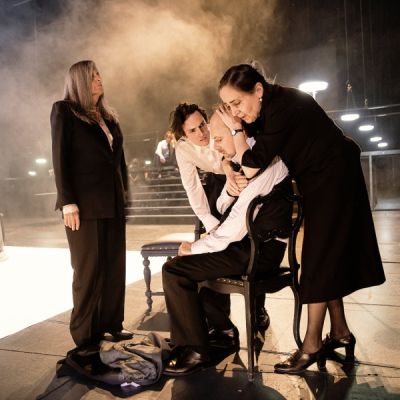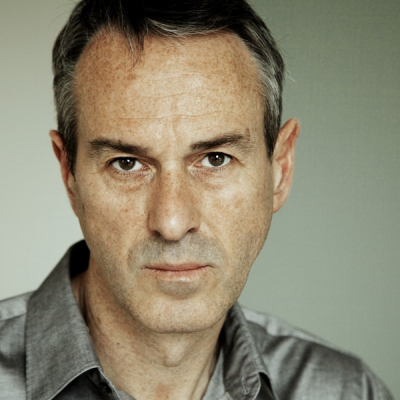Tartuffe or the Hypocrite 14
Three-act version censored by Louis XIV

Comédie Française, Paris, France
Director: Ivo van Hove
Performed in French with Hungarian subtitles
2 hours, without breaks.
STORYLINE
Orgon is a wealthy bourgeois, widowed from a first marriage that gave him a son, Damis, and remarried to Elmire. He takes in Tartuffe, a so-called man of the cloth whom he admires, offering him room and board and putting him on a pedestal. However, Tartuffe is only after the fortune of his host, who pitifully allows himself to be deceived and abused by Tartuffe’s false devotion, just like his mother, Madame Pernelle. A conflict arises between Damis and his father, who delays the son’s marriage under the influence of his new “director of conscience”. The all-powerful Tartuffe even tries to seduce the wife of his benefactor. Despite Elmire’s desire to keep the affair a secret, Damis comes across a golden opportunity and denounces the affront of their troublesome guest to his father: but Orgon refuses to believe him, chases his son away, curses him and wants to make Tartuffe his sole heir. Elmire, driven by the need to obtain Damis’s pardon, is forced to open Orgon’s eyes to the real Tartuffe. She sets a trap for Tartuffe, who renews his assault on her in front of Orgon, hiding in the same room.
CHOOSING A VERSION
Ivo van Hove has chosen a text that is not the five-act version written by Molière in 1669 and usually staged. It is the reconstitution of a lost version of the play. This three-act “Tartuffe”, whose title is “Le Tartuffe ou l’Hypocrite”, was indeed censored when first shown to Louis XIV in 1664. The university lecturer Georges Forestier, specialist of 17th c. theatre history explains it so: this “very christian king” could not on the one hand claim to be the champion of Catholic orthodoxy and on the other hand let his favourite author-comedian show a satire of bigots in his Parisian theatre. Molière then rewrites his play, extends it to five acts that become in 1669 “Le Tartuffe ou l’Imposteur” that we know. Georges Forestier and Isabelle Grellet reconstituted “Le Tartuffe ou l’Hypocrite” from archives, but also from dramaturgical research on the structure of the play in its two versions (cf. p. 8).
MISSION STATEMENT
by Ivo van Hove
Is Tartuffe an impostor? Yes, of course he is. He pretends to be something he is not: a devotee. Nevertheless, his deception has the virtue of exposing the secret tensions and desires that lurk in Orgon's family. It is a wounded family. A seemingly stable family in which respect for elders and parental authority are reliable and unshakeable foundations. On closer inspection, however, the family has collapsed into the ruins of its past. Orgon's wife has died and he has remarried to Elmire, a much younger woman. This union turns out to be a marriage in crisis. Damis rebels against his father, Orgon, who has obstructed his marriage. Cléante, Elmire's brother, has a decidedly progressive, libertine and individualistic view of society, which clashes with the traditionally conservative thinking of Orgon and his mother, Mme Pernelle. Unity and harmony have long since left this house. Tartuffe then infiltrates this household on the verge of explosion. He is a beggar, a miserable man who lives from day to day, collecting alms from church to church. A life of survival. Tartuffe is given the role of saviour, of devotee, by Orgon. A good actor, he plays this role for the money and for a better life in which he can wash at least once a week and wear clean clothes. Orgon finds in him a friend, a confidant, with whom he can share his worries and difficulties. Tartuffe turns out to be the perfect carer, friend and spiritual teacher. The authentic relationship that develops between these two men is fundamental. To seal this unique bond, Orgon decides to make Tartuffe his sole heir. The bomb explodes. Like many of Molière's comedies, Tartuffe is a social drama. The author shows how major social developments have an irrefutable influence on the psychological, social and emotional lives of individuals. I chose to stage the original version of this play, which has only three acts. It focuses on the love scenes between Elmire and Tartuffe and the battle between Damis and his father Orgon. The strength of this version of Tartuffe is brutal.
NOTE ON THE RECONSTRUCTION OF THE PLAY
by Georges Forestier
The material of Acts 1, 3 and 4 as we know it (with the exception of the last scene of Act 4) corresponds to the many narrative and dramatic versions of the story of the cleric-overlord who attempts to seduce his host’s wife, is unmasked by her cunning, and is finally driven away from the house. These three acts clearly reveal the underlying structure that can be found in earlier novels as well as in “dell’arte” versions: 1) a devout husband welcomes into his home a man who seems himself the embodiment of the most perfect devotion; 2) the latter, having fallen in love with the young wife of his host, tries to seduce her, but she rebuffs him while being reluctant to denounce him to her husband who, informed by a witness to the scene, refuses to believe him; 3) her husband’s blind trust in the holy man then obliges his wife to show him the hypocrisy of the fake devotee by having him witness a second attempt at seduction, after which the guilty party is driven out of the house. On the other hand, these three sequences form an action that is sufficient in itself, and it is understandable that Molière should have set out to compose a comedy in three acts: the exposition in the first act, a second act organised around the attempted seduction, and a third act based around the trap set by the wife. It is also easy to see how what was to be the initial denouement (Tartuffe driven out) was later extended by a twist that leads to the fifth act of the final version (Tartuffe in possession of a donation of all of Orgon’s assets and a box containing the compromising documents). It should be noted that, in this three-act structure, the love affair between Mariane and Valère, which constitutes the whole of Act 2 in the final version, cannot find its place; moreover, it is excluded by what we know of Tartuffe’s original appearance, a carbon copy of those lay directors of conscience who bore witness to their austere and chaste devotion by their quasi-ecclesiastical garb: a director of conscience who, like his confreres, had taken a vow of celibacy could not have been thinking of marrying his host’s daughter. Conversely, Damis’s violence towards Tartuffe at the beginning of Act 3 of the final version – a violence that is hardly understandable and artificially justified in the five-act version we know – and several allusions to his own marriage, which is clearly hindered by the devotee’s criticism, bear witness to an earlier version in which, in the absence of Valère and Mariane, the trigger for the crisis was Damis’s thwarted marriage. We can thus understand how Molière, after adding a fourth act (Act 5 in the version we know), completed his play by composing yet another act which, having become Act 2 in the final version, seemed to so many critics to be poorly integrated into the overall play. And we discover why the main character’s entrance on stage only occurs in Act 3. This textbook case of dramaturgical studies (Tartuffe is considered a perfect example of the “delayed hero”) is in fact the result of an unpremeditated work of amplification of a play conceived as a comedy in three acts... In the first version of 1664, Tartuffe appeared as early as Act 2, which would not have been considered in any way out of the ordinary.
MADAME PERNELLE, mother of Orgon - Claude Mathieu
ORGON, husband of Elmire - Denis Podalydès
CLÉANTE, brother-in-law of Orgon - Guillaume Gallienne
TARTUFFE, a hypocrite - Christophe Montenez
DORINE, Mariane’s maid - Dominique Blanc
DAMIS, son of Orgon - Julien Frison
ELMIRE, wife of Orgon - Marina Hands
and sevants –
Clémentine Billy, Sanda Bourenane, Vincent Breton, Olivier Debbasch, Ipek Kinay, Alexandre Manbon
Dramaturgy: Koen Tachelet
Sets and lights: Jan Versweyveld
Costumes: An D’Huys
Assistantship to the direction: Laurent Delvert
Assistantship to the sets: Jordan Vincent
Assistantship to the lights: François Thouret

















